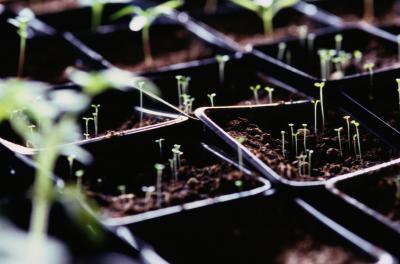 Winter is the time when many greenhouse owners are thinking about starting seeds. They may be reading through catalogs, cleaning pots, checking their supply of potting soil, and perhaps placing orders. But one thing that is often overlooked is a heating mat to go under your seed flats. With the gentle bottom heat that a heating mat provides, seeds can be started earlier and growing seasons can be extended, all of which can help increase the enjoyment of a greenhouse.
Winter is the time when many greenhouse owners are thinking about starting seeds. They may be reading through catalogs, cleaning pots, checking their supply of potting soil, and perhaps placing orders. But one thing that is often overlooked is a heating mat to go under your seed flats. With the gentle bottom heat that a heating mat provides, seeds can be started earlier and growing seasons can be extended, all of which can help increase the enjoyment of a greenhouse.
Heating mats come in various sizes. Typical ones range from 11in. x 22in. (a single-tray size) to 60in. x 22in. (accommodating five trays). I bought the largest one I could fit on my greenhouse table (36in. x 22in.) because I start a lot of seeds. If you want an even bigger mat, you can find ones 11in. wide and up to 25ft. long on websites aimed at commercial growers.
What do heating mats cost? A single-tray mat with a temperature regulator will generally cost between $30 and $50, while one that measures 36in. x 22in. will cost about $100. Most mats don’t use much power and so aren’t highly expensive to operate. Without causing an obvious electric bill spike, they can be left on for long periods of time while seeds are germinating and young plants are getting established.
When buying a heating mat, select one with a temperature regulator or thermostat. Some mats heat up to 130o F, but with a thermostat the level of heat can be easily controlled. You can also purchase a sensor to put in one of your pots to measure the soil temperature. With a combination of soil sensor and heating mat thermostat, you can make sure that your plants aren’t being either over- or under-heated.
The soil temperature to aim for will vary depending on two factors: type of plant and stage of development. I keep the temperature between 70o and 80o F while germinating seeds, with my pepper and tomato seeds receiving the higher end of this range. After germination, I generally let the soil temperature drop to 60o F, although I adjust that temperature depending upon the particular kind of plant. For example, lettuce plants should be grown at only 50o to 55o F, whereas pepper and tomato plants should be maintained at around 70o. With a little research and experimentation you can find the right temperature to keep each of your plants growing well. Here is a web site that has all of the information you will need on temperatures for seeds and growing. http://tomclothier.hort.net/


